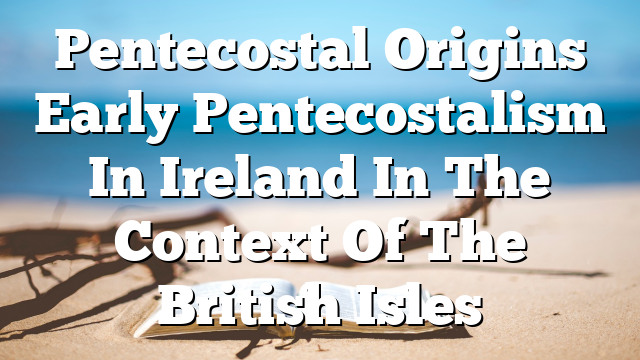Click to join the conversation with over 500,000 Pentecostal believers and scholars
Click to get our FREE MOBILE APP and stay connected
| PentecostalTheology.com



Book Reviews / Pneuma 29 (2007) 131-178
171
James Robinson, Pentecostal Origins: Early Pentecostalism in Ireland in the Context of the British Isles (Carlisle: Paternoster Press, 2005). xxvii + 360 pp. £24.99 paperback.
It may have come to the attention of those with an active interest in Pentecostal scholarship that amid a proliferating and international representation across a range of studies, British contributions, particularly in the field of historical investigation, have been conspicuous by their absence. While this peculiarity merits exploration in its own right, it is pertinent in this context to state at the outset that this publication represents a notable contribution toward the filling of this scholarly vacuum.
Robinson discloses in a “Bibliographical Note” that as an Ulsterman he came from a background “where some of the personalities that appear in these pages were regularly spo- ken of, sometimes entertained, or occasionally listened to as preachers” (p. 335). He further ventures that a bequest from his father, himself a Pentecostal preacher, had the effect of arousing, over many years, an interest in historical source materials. It was the case that an otherwise unprepossessing first minute book of the Belfast and District Presbytery of the Assemblies of God ultimately furnished a “compelling inspiration” which proved the cata- lyst for his subsequent researches. One of the most commendable features of the resultant volume is its author’s capacity to synthesize an “imaginative sympathy” with Pentecostals, and indeed the variegated contours of religion in Ulster, with a creditable academic approach. The outcome is a study which will inform those in search of recondite detail specific to the region, while bringing neglected aspects of the Pentecostal heritage to the attention of a deservedly wider audience.
After initially outlining “roots of British Pentecostalism” such as the Keswick Movement and the Welsh Revival, Robinson proceeds to explore “proto-Pentecostal currents in Ire- land.” Tese include the Faith Mission, the Cooneyites, and the localized activities of the Zion Movement associated with John Alexander Dowie. T ere follows an engaging case- study in the form of a chapter devoted to the spiritual odyssey and Pentecostal involvement of Arthur Booth-Clibborn (1855-1939), husband of Catherine Booth, esteemed through- out the Salvation Army as La Marechale. Observations are made with respect of the influence of this patriarchal Anglo-Irish figure on nascent British Pentecostalism. In the light of the fact that this emerging religious constituency was the beneficiary of the twilight years of prominent activists such as Cecil Polhill (1860-1938) who was most notable for his status as one of the China Inland Mission’s “Cambridge Seven,” it is wholly appropriate that the contribution of Booth-Clibborn receives attention in the context of this study.
Robinson acknowledges that Confidence, the periodical founded and edited by the Rev. Alexander A. Boddy from 1908, represents “almost the only source of information about the movement in the province in its pre-denominational stage” (p. 336). It is there- fore no surprise that it forms the basis of a section dealing with an array of figures who associated themselves with the Pentecostal cause prior to the First World War. Influences that emanated from Sunderland in particular, and mainland Britain in general, are acknowl- edged throughout subsequent chapters which deal with the foundation, activities, and development of both the Elim Evangelistic Band and Pentecostal Alliance, and the Apos- tolic Church in Ireland. The greatest concentration rests, it must be stated, with the former, the latter meriting inclusion by virtue of the fact that it constituted what is termed “the first
© Koninklijke Brill NV, Leiden, 2007 DOI: 10.1163/157007407X178481
PPNEU 29,1_f9_131-178.indd 171NEU 29,1_f9_131-178.indd 171
3/30/07 8:48:28 PM3/30/07 8:48:28 PM
1
172
Book Reviews / Pneuma 29 (2007) 131-178
serious challenge to the hegemony of Elim in the province” (p. xxvi). Some readers may find themselves initially perplexed at the scant attention given to the Britain’s largest Pente- costal denomination, the Assemblies of God, in this self-designated “synoptic regional study” (p. xxvi). It becomes abundantly apparent, however, that this is on account of Rob- inson’s sustained regional focus, a perspective which incorporates a wealth of local, inter- personal, and organizational detail relating to such Pentecostal bodies as established themselves in Ireland prior to 1925.
It would be mistaken, nonetheless, to categorize Robinson’s work as merely provincial in interest. His reconstruction of developments in one region of the British Isles brings fasci- nating aspects of Pentecostal heritage to light, and in this vein, latter-day Pentecostals can- not but be enlightened by such disclosures as the fact that pioneering figures resolutely retained an irenic disposition amid a climate of mutual suspicion and widespread denun- ciation. This substantial study, augmented as it is by an assortment of charts, diagrams, photographic and other visual artifacts, represents a significant contribution to the under- standing of how Pentecostal Christianity came to root itself in specific religious infrastruc- tures, and its author has demonstrated himself to be a competent and sympathetic arbiter of this particular localized expression.
Reviewed by Tim Walsh
PPNEU 29,1_f9_131-178.indd 172NEU 29,1_f9_131-178.indd 172
33/30/07 8:48:29 PM/30/07 8:48:29 PM
2


